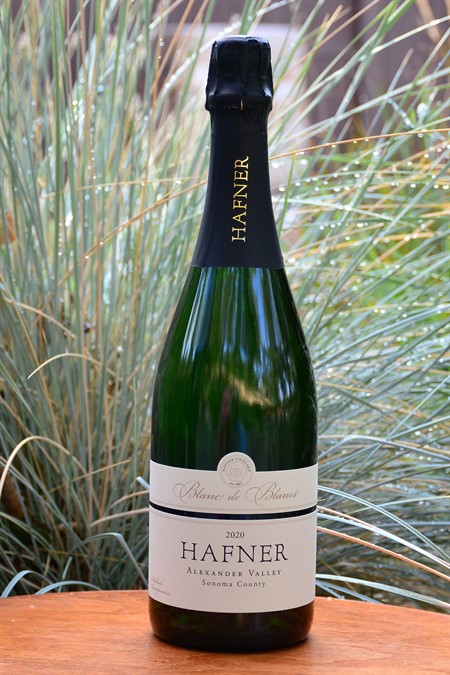Blanc de Blancs Packaging
- October 19, 2023
Creating a new wine label is both exciting and intimidating. As a member of the production team, I know the wine intimately: how it is made and how it has evolved. As the designer of the label, I want to capture its essence and reflect its heritage. For me, the label should be both timeless and representative of Hafner Vineyard.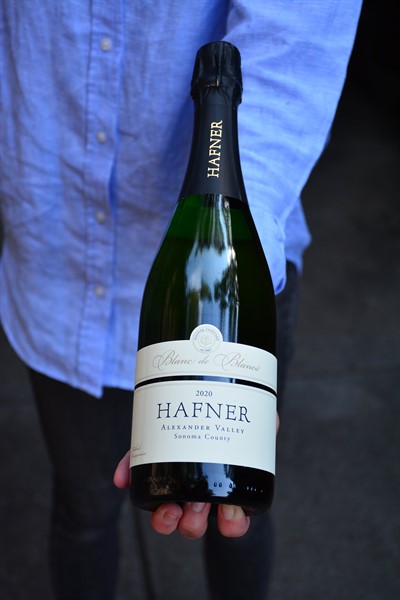 I have been working for the past year and a half on a new label for our newest wine, our 2020 Blanc de Blancs sparkling wine. The process of making sparkling wine is long and very detailed…the process of creating the label has mirrored our winemaking. Creating a new label is challenging. I begin by researching wine labels…ones that I have collected over the years and ones that I find at the wine shops. Although bright, vibrant labels are fun (and I have some in my collection of favorites), they do not resonate with our brand. We make our wines in a classic, elegant, refined style and hence our label needs to reflect that.
I have been working for the past year and a half on a new label for our newest wine, our 2020 Blanc de Blancs sparkling wine. The process of making sparkling wine is long and very detailed…the process of creating the label has mirrored our winemaking. Creating a new label is challenging. I begin by researching wine labels…ones that I have collected over the years and ones that I find at the wine shops. Although bright, vibrant labels are fun (and I have some in my collection of favorites), they do not resonate with our brand. We make our wines in a classic, elegant, refined style and hence our label needs to reflect that.
After I have collected a variety of labels, we (Parke, Scott, Kate and I) gather at our home to discuss what we like, what we dislike and why. We also review our current labels – how they are distinctive from one another, but also retain a similar style and tone. I note everyone’s comments and get to work.
Designing a wine label is not free and imaginative as one may think. There are a few requirements. First, the bottle shape determines the size and shape of the label. Then, the government, specifically the TTB (Tax and Trade Bureau), oversees wine label regulations and must approve each label before the wine is sold. The label requirements for sparkling wine are different from still wines, so learning those requirements is essential. And finally, I must ensure that the new label incorporates the elements of our other labels…typefaces, colors, logos…all the while being a new and distinctive label.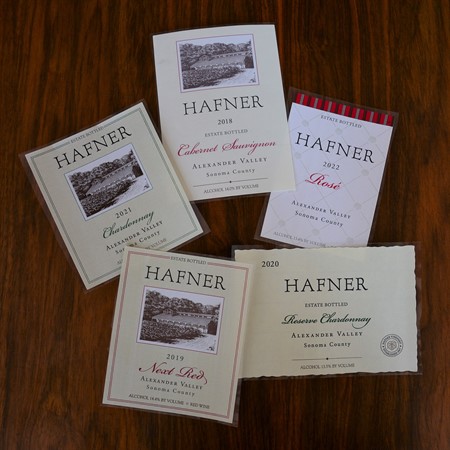 Our Reserve Chardonnay program is a tribute to Parke’s mentor at Domaine des Comtes Lafon, so when I designed the Reserve label, I wanted to reflect the Burgundian influence. Similarly, our Blanc de Blancs is made in the “Méthode Champenoise” process and hence I wanted our sparkling label to be reminiscent of a vintage Champagne.
Our Reserve Chardonnay program is a tribute to Parke’s mentor at Domaine des Comtes Lafon, so when I designed the Reserve label, I wanted to reflect the Burgundian influence. Similarly, our Blanc de Blancs is made in the “Méthode Champenoise” process and hence I wanted our sparkling label to be reminiscent of a vintage Champagne.
We had several design meetings where we looked at a variety of Hafner Blanc de Blancs labels that I had created and at the end of each, I went back to my design program and made the suggested changes. Sometimes, those changes inspired other tweaks and sometimes they improved the design; other times they did not. Together, we decided on the form and its elements, and I created the design.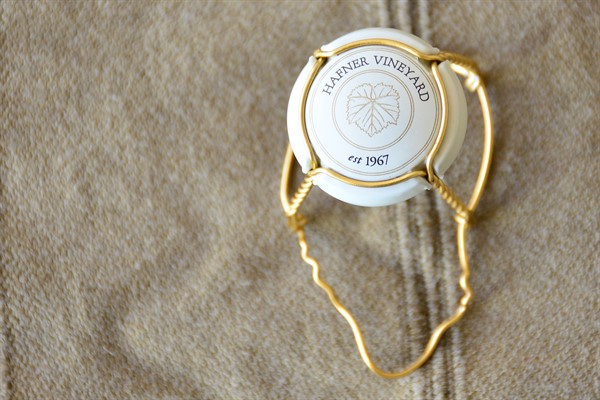 We felt that it was important to use the phrases “Blanc de Blancs” and “Méthode Champenoise” on the front label, because they designate a level of craftsmanship that we use to make our sparkling wine. “Blanc de Blancs” means the grapes used are 100% Chardonnay and “Méthode Champenoise” denotes the style in which it was produced…fermented in the bottle. (For more information on our production techniques, read Parke’s blog here.)
We felt that it was important to use the phrases “Blanc de Blancs” and “Méthode Champenoise” on the front label, because they designate a level of craftsmanship that we use to make our sparkling wine. “Blanc de Blancs” means the grapes used are 100% Chardonnay and “Méthode Champenoise” denotes the style in which it was produced…fermented in the bottle. (For more information on our production techniques, read Parke’s blog here.)
We have two logos that we use on our labels…the illustration of the winery (which is on the main Chardonnay, Cabernet and Next Red labels) and the double rule circle with a Chardonnay leaf (which is on the Reserve label). We decided that the circle logo was most reminiscent of a Champagne label. The placement of that logo took some time, but we finally decided at the top, in a place of prominence was the most appropriate.
With the label designed, we needed to find the perfect paper. I love the classic laid paper that evokes age and elegance. More importantly though, the paper had to be ice proof…it had to withstand an hour or two in an ice bucket! After talking with several paper manufacturers and testing the papers they suggested, I found one that fit both criteria.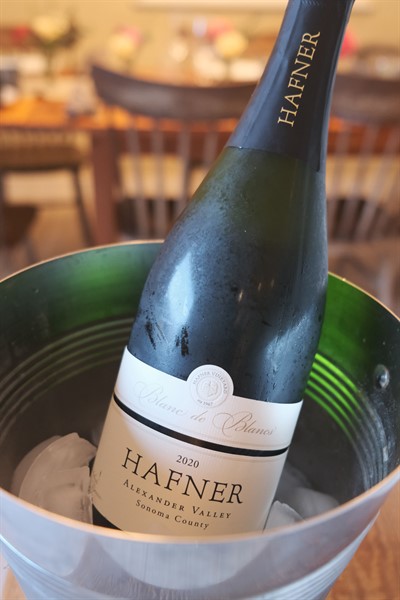 A Sparkling wine package has four components: the label, the foil, the cork and the muselet (the wire hood and tin cap). With the design of the label finished, I started work on the remaining three elements. Do we put “Hafner” around the foil or down; what color should the foil be; should we put an “H” or “Hafner” or both on the cork; what elements should go on the tin cap; what colors should the cap and wire hood be? The questions seemed endless, but slowly we made decisions and finished the entire package.
A Sparkling wine package has four components: the label, the foil, the cork and the muselet (the wire hood and tin cap). With the design of the label finished, I started work on the remaining three elements. Do we put “Hafner” around the foil or down; what color should the foil be; should we put an “H” or “Hafner” or both on the cork; what elements should go on the tin cap; what colors should the cap and wire hood be? The questions seemed endless, but slowly we made decisions and finished the entire package.
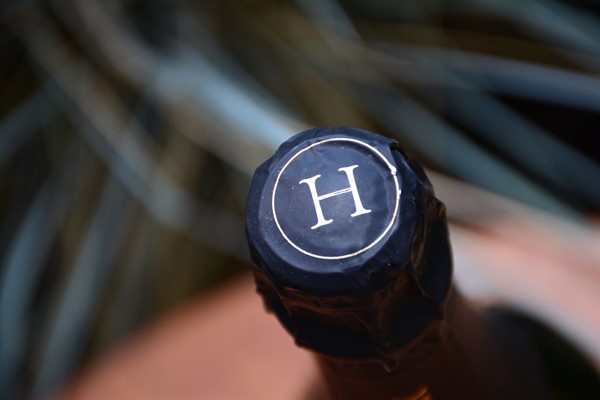 When the corks, foils, and muselets arrived from Italy, I began getting excited. The design package was coming together. When I saw the label at the press check, I was grateful for the time we spent creating it. When the sparkling wine was finally disgorged and labeled, I held the finished bottle in my hand and smiled. The Hafner Blanc de Blancs was finally here and ready to be enjoyed.
When the corks, foils, and muselets arrived from Italy, I began getting excited. The design package was coming together. When I saw the label at the press check, I was grateful for the time we spent creating it. When the sparkling wine was finally disgorged and labeled, I held the finished bottle in my hand and smiled. The Hafner Blanc de Blancs was finally here and ready to be enjoyed.
We invite you to order the Blanc de Blancs here. 